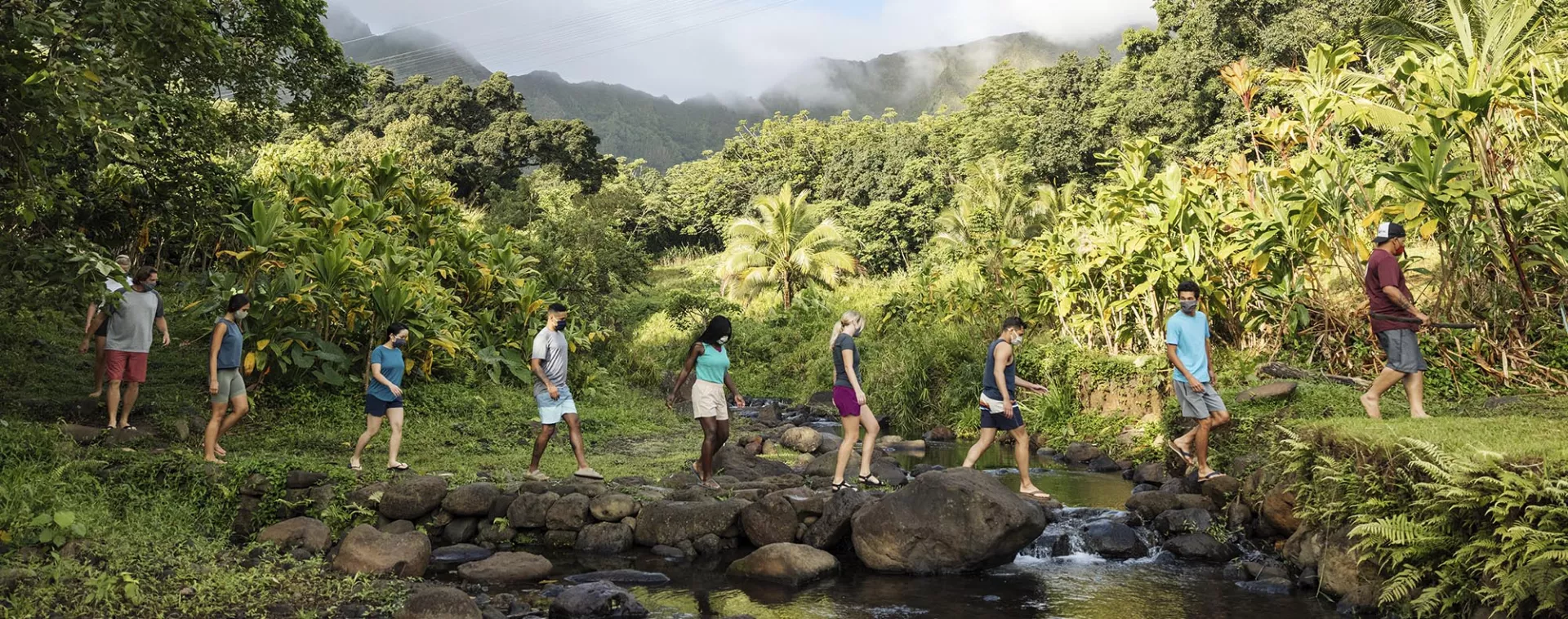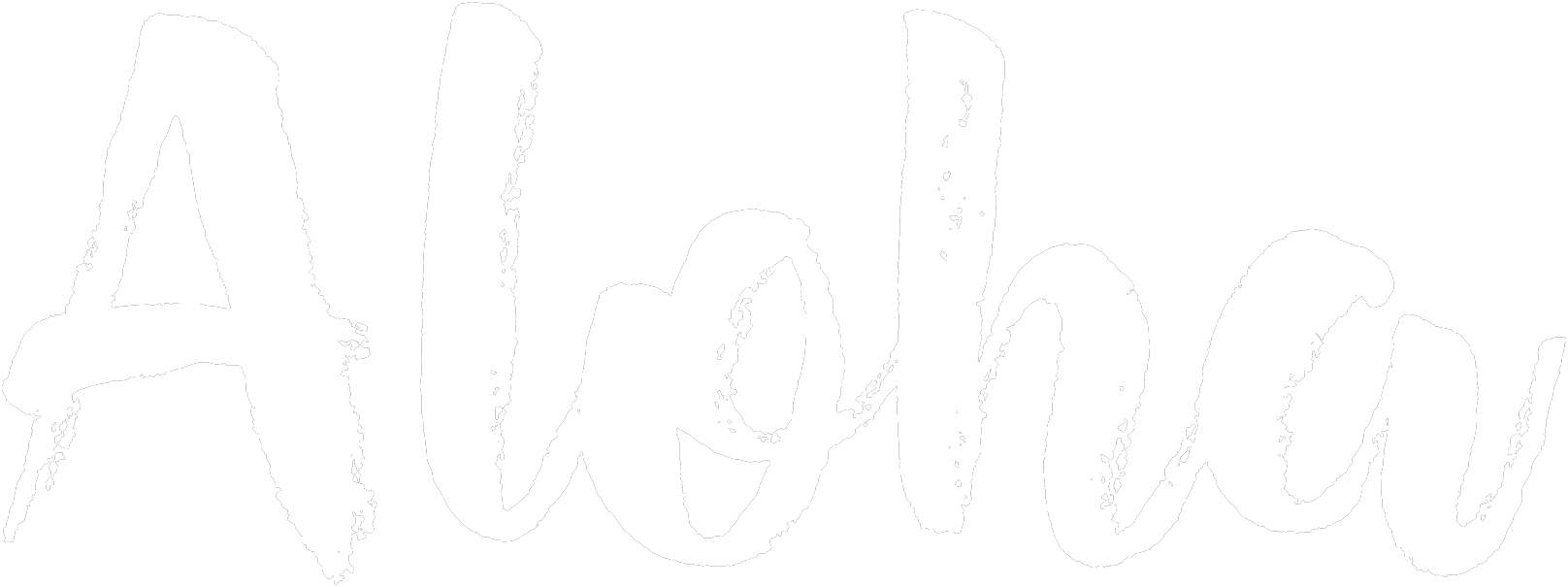
 Sustainable Farming
Sustainable Farming
Rick Barboza
Papahana Kuaola, Co-founder
The distinctive ridges of the Koʻolau mountains are a riot of green in the contrasting sunlit ridges and shaded valleys. They’re similar to the ridges in the elegant leaf of a rare species of kalo (taro) growing far below, in a muddy patch at the idyllic Papahana Kuaola, a community farm co-founded by Rick Barboza, that’s just as much a seed bank and living botanical garden.
Volunteers laugh as they awkwardly amble in the knee- and even thigh-deep mud of the loʻi (taro patch), helping to harvest the plant from which native Hawaiians are mythically descended. As they’ll learn, they’re not just mucking about in the mire - they’re helping to restore and fortify the ancestral connection between human and ecosystem that defines Hawaiʻi.
Guiding them to replant taro huli (cuttings), Rick laughs with his visitors. He knows the mud may wash off their arms and legs in the waterfall later, but it will leave an indelible memory of what it means to mālama ʻāina (care for the land).
What does sustainability mean at Papahana Kuaola?
How we interpret sustainability is transforming land back to ʻāina. ‘Āina translates to land but a deeper translation would be “that which feeds.” But not just feeding us humans. It's feeding the animals and plants that make up Hawaiʻi. Feeding the plants, feeding the insects that feed on the plants, feeding the birds that feed on the plants or the insects. So ʻāina is that which feeds the ecosystems and the ecology, by providing habitats to allow native species to thrive. Ultimately, it allows us as a people to thrive as well. That’s true sustainability.Why “back” to ʻāina? Isn’t it already ʻāina?
Ancestrally speaking, it was. Hawaiʻi was just one big functioning ecosystem made up of many micro ecosystems, right? And so when our ancestors got here, they recognized that. They knew that they couldn't deplete all of its resources for their benefit. And the loʻi is a perfect example of how. They divert water out of the stream, feed the loʻi, feed the kalo within the loʻi, but then be sure to put that water back into the stream. And took a handful of kalo varieties and kind of sped up evolution, took it to a count of over 300 different named varieties of kalo. Today, we've lost the majority of those, we only have around 80 varieties left. We have most of them in our bank of Hawaiian food cultivars, which we like to make available for new starting farmers.You know, commercially for years, all of the largest poi producers focused on the varieties that work best for them, which is fine, but it was mostly limited to two varieties of kalo. But there's so much more. If you ask somebody to describe poi, what does it look like? "Oh, it's pasty and grey." But that's true for one or two varieties. But we have varieties that are pink, we have varieties that are yellow, we have varieties that are tan. We have varieties that are, like, when you pound it, it’s plastic - it has great shape, and consistency, and texture. But a lot of these varieties were lost. And all of these centuries of culture building are lost with the loss of a plant.
It's a sad thought that we have to transform land back to ʻāina in Hawaiʻi. You would think that we're surrounded by ʻāina in Hawaiʻi. But we're not surrounded by the plants that make up ʻāina. We're surrounded by invasive plants being grown on the land.
So how can we get it back ʻāina?
We need to feed the land before we feed ourselves. We need to be mindful of our presence, what we do and where we are, to keep that ʻāina functional. We're reinventing the wheel that, you know, for whatever reason we decided to not use the wheel anymore. And now we're like, "We should have kept that wheel!” And it's like, "Okay, how do you build the wheel? Let's go back to our kūpuna (ancestors), and let's ask them, the ones that used the wheel last.” Scientists now recognize that our kūpuna understood how ecosystems work and how people impact ecosystems. And if we continue to negatively impact ecosystems, then in the long run we're really going to feel negative results. But if instead we want to start providing for our family, and our children, and our grandchildren, sustainably, we really have to mālama the land.How do you mālama the land?
The word mālama often just translates to taking care but it also translates to the light. And so when you mālama a place, you know, you get to see the true light of that space. Today we go into these lowland forests that are just completely overrun with invasive species. Canopies that don't allow sunlight to penetrate through - not typical of a native forest canopy, which allows a lot of sunlight to come in. And you start opening up that canopy, and you start taking care of that land and removing those trees, and you let the sunlight in. That sunlight provides space to produce, whether it's restoration of producing plants that help the entire ecosystem, or opening up space for farming.And then at that point you practice typical farming?
Farmers typically have wanted to produce one thing on a grand scale on landscapes that aren't necessarily fitting for that particular product, right? On a typical farm, a lot of times the area is stripped, your seeds are planted, you fertilize it and you bring water to it.When it comes to kalo and other forms of Hawaiian agriculture, you let nature provide. We are located where the source of the water kind of begins, we have a spring on our property. But we're passing on water that everybody else in the community can also utilize for their farming needs. And our nursery provides the right plant material that doesn't suck up excessive water, but also helps to capture rainwater to feed back down into the aquifers and, ultimately, into the streams and into the springs. Instead of utilizing fertilizers, you have natural fertilizers that come from plant material that gets put into the mud and left to dry out. So we're not removing elements from the natural landscape, we're kind of borrowing it and then utilizing it to produce food, but also ultimately returning it. So it's not depleting what we have, and replacing it with something else. It’s trying to take the most advantage of what we have available. And that even goes all the way down to the sunlight, and to the wind, and to the rain.
How do visitors fit in?
That’s part of sustainability, too. There's always going to be some sort of negative impact for places, regardless if you're indigenous to that space or not. And it's up to you as an individual how much impact you want to put into that space. So that when you leave, how is that space going to feel? How is that space changed?Local or visitor, coming to a place and taking care of that place, making that place better when you leave than how it was before you got there, that's the type of mentality that's going to sustain us generation after generation.
And so if we're able to have visitors come and not just remove invasives or help plant kalo, but get the full blown experience of what sustainable agriculture in Hawaiʻi really is, man, that’s almost life changing for a lot of people.
